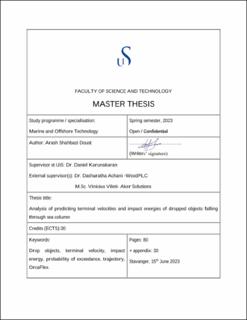| dc.description.abstract | Many offshore operations include risks that might lead to catastrophic consequences. One of the most common offshore risks is the unintentional drop of objects during various marine operations. This work is divided into two main parts. The first part of the thesis is to perform numerical simulations using OrcaFlex to determine the motion trajectory, terminal velocity, and maximum velocity of the cylindrical dropped object. The numerical study is based on the 3D theory for dropped objects. The study begins by investigating the small-scale model of size 1:20.32 followed by simulating the full-scaled model selected from Aanesland et al. (1987). The numerical results for the small-scaled model are validated with the experimental data available in the literature. The numerical results show that drop angle, normal drag force and normal drag moment coefficients, and Munk moment coefficient are the most critical factors that determine the trajectories of the dropped object. The results also show that drop angle has no effect on maximum velocity, but it determines the landing location, especially in shallow water regions. For the 0° drop angle of the small-scale model, the terminal velocity obtained using numerical simulation shows a good agreement with experimental results and analytical calculation. However, for the same, 90° drop angle, the terminal velocity obtained using numerical simulation is 12 % higher than the experiment due to smooth cylinder assumption. The object’s trajectory obtained for a small-scale model for different drop angles also shows good agreement with the experimental results. For the full-scale model, the highest maximum velocity that an object can attain during an excursion in certain water depths is observed for the Munk moment coefficient in the range of 0.08 to 0.20. It is also observed that the maximum impact energy of the full-scale model will be constant after 400 m water depth for different combinations of Munk moment coefficients and drag moment coefficients.
Finally, the probability of exceedance and probability of impact is calculated for the full-scale model based on DNV-RP-F107 and results are compared with the numerical simulations. The results show that the probability of exceedances increases with water depth, while it decreases by increasing the horizontal distance from the drop location. The results also show a higher probability of impact at far horizontal locations using numerical simulation as compared to DNV-RP-F107 and vice-versa for short horizontal distances from the drop location. | |
